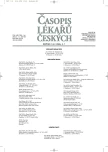Diagnostic Aspects of Familial Juvenile Hyperuriceamic Nephropathy
Diagnostické aspekty familiární juvenilní hyperurikemické nefropatie
Východisko.
Familiární juvenilní hyperurikemická nefropatie je autozomálně dominantně dědičné onemocnění charakteristické hyperurikémií, dnou a progresivním renálním selháním. Autoři předkládají popis onemocnění a přehled klinických a biochemických příznaků u pacientů s familiární juvenilní hyperurikemickou nefropatií v české populaci.
Metody a výsledky.
Na základě rodinné anamnézy byly vytvořeny rodokmeny 3 českých rodin s familiární juvenilní hyperurikemickou nefropatií. Celkem u 57 jedinců byl odebrán biologický materiál pro biochemická vyšetření a izolaci genomové DNA (krev, moč). Byly vyšetřeny koncentrace kyseliny močové a kreatininu v séru a moči a určeny hodnoty exkreční frakce kyseliny močové a Kaufmanova indexu. Na základě vyšetření purinového metabolizmu byla potvrzena či nově určena diagnóza familiární juvenilní hyperurikemické nefropatie celkem u 19 pacientů, 1 pacientka byla diagnostikována na podkladě vazebné analýzy.
Závěry.
Familiární juvenilní hyperurikemická nefropatie je onemocnění sdílící nespecifické klinické a biochemické nálezy se skupinou familiárních renálních onemocnění. Diagnostika onemocnění je ztížená heterogenitou familiární juvenilní hyperurikemické nefropatie a omezenou možností molekulárně genetické diagnostiky. Nezbytné je určení detailní rodinné historie, biochemické vyšetření a podrobné vyšetření purinového metabolizmu v rodinách s nálezem hyperurikémie a/nebo dny (především u dítěte či mladé ženy) a/nebo familiárního renálního onemocnění.
Klíčová slova:
familiární juvenilní hyperurikemická nefropatie, hyperurikémie, dna, renální selhání, exkreční frakce kyseliny močové, uromodulin.
Authors:
B. Stibůrková 1; I. Šebesta 1,2; S. Kmoch 1,3
Authors‘ workplace:
Ústav dědičných metabolických poruch 1. LF UK, Praha
1; Ústav klinické biochemie a laboratorní diagnostiky 1. LF UK, Praha
2; Centrum aplikované genomiky, Praha
3
Published in:
Čas. Lék. čes. 2005; 144: 466-471
Category:
Original Article
Overview
Background.
Familial juvenile hyperuricemic nephropathy (FJHN) is a genetic disorder with the autosomal dominant mode of hereditability; characterized with hyperuricemia, gout and progressive renal disease. Characterization of the disease together with clinical and biochemical findings in patients of Czech population is described.
Methods and Results.
The bloodlines of three Czech families with FJHN were set up on the basis of their family history. The specimens of blood and urine were taken from 57 family members for biochemical investigations and isolations of genomic DNA. Blood and urinary concentrations of the uric acid and creatinine together with values of excretion fraction of uric acid and Kaufman’s index were determined. Based on these results diagnosis of FJHN was established or confirmed in 19 patients. One additional patient was diagnosed on the results of linkage analysis.
Conclusions.
FJHN is a disorder sharing non-specific clinical and biochemical signs with the group of familial renal disorders. The effective diagnosis is difficult due to the heterogeneity of the disorder and limited availability of molecular genetic analysis. Detailed purine metabolic investigation together with precise family history is thus necessary and very important in family members with hyperuricemia and/or gout (particularly in childhood or young women) as well as in patients with familial renal disease.
Key words:
familial juvenile hyperuricemic nephropathy, hyperuricemia, gout, renal failure, excretion fraction of uric acid, uromodulin.
Labels
Addictology Allergology and clinical immunology Angiology Audiology Clinical biochemistry Dermatology & STDs Paediatric gastroenterology Paediatric surgery Paediatric cardiology Paediatric neurology Paediatric ENT Paediatric psychiatry Paediatric rheumatology Diabetology Pharmacy Vascular surgery Pain management Dental HygienistArticle was published in
Journal of Czech Physicians

- Metamizole vs. Tramadol in Postoperative Analgesia
- Metamizole at a Glance and in Practice – Effective Non-Opioid Analgesic for All Ages
- Advances in the Treatment of Myasthenia Gravis on the Horizon
- What Effect Can Be Expected from Limosilactobacillus reuteri in Mucositis and Peri-Implantitis?
- The Importance of Hydration in Wound Healing
Most read in this issue
- Diagnostic Aspects of Familial Juvenile Hyperuriceamic Nephropathy
- Contemporary View on Mild Brain Injuries in Adult Population
- Surgical Treatment of Atrial Fibrillat
- Small Bowel Transplantation
